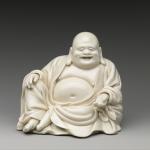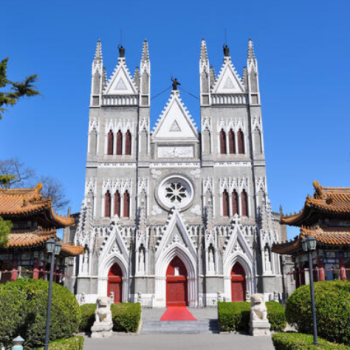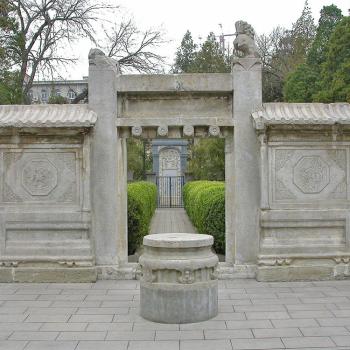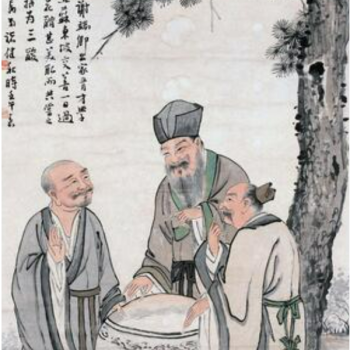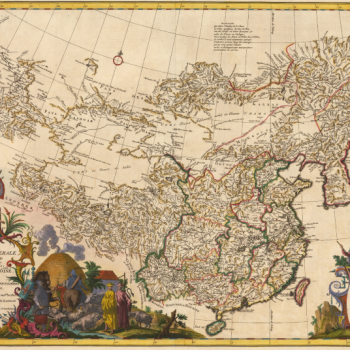Before we can adequately discuss the nature of this popular sectarianism and its own tripartite scheme of history, we have to acknowledge how far Chinese apocalyptic thought had come since we last examined it in the immediate centuries after the fall of the Han Dynasty. The biggest new development was the introduction of a new religion into the Chinese cultural sphere. With it came a new messiah. When we last looked at China, the apocalyptic atmosphere was largely Taoist and the expected savior was a figure bearing the surname of “Li,” and often, but not always, the given name of “Hong.” This character ultimately derived from a pro-Han Dynasty prophecy that emerged during Wang Mang’s usurpation at the beginning of the first century A.D. and his popularity only seemed to grow from there. But by the sixth and seventh centuries, Chinese apocalyptic thought was already moving on from him. He did not disappear entirely, for as late as the seventeenth century, the savior surnamed Li was still awaited in some quarters. But for the most part, Li Hong soon ceased to be a major figure in the popular apocalyptic story, pushed offstage by the shiny new messiahs offered by the new religion.
That religion was Buddhism. Already ancient in its native India, it began to make inroads into China in the second period of the Han Dynasty, after Wang Mang’s usurpation had been ended and the messianic promise of a restored Han had seemingly been fulfilled. But this faith did not catch on as a truly popular religion until after the Han’s fall, during those four chaotic centuries when fragmentation, rival warlords, and short-lived dynasties were the norm. Buddhism’s success in burrowing itself deep into China’s cultural life at this time has been credited to a number of factors. The one most often cited is the determined missionary drive undertaken by foreign monks in these centuries to bring Buddhist holy texts to China and translate them into the vernacular. Another possible factor is far more speculative; numerous scholars have proposed that Buddhism, with its basic tenet that all life is suffering, appealed far more to a people living through these brutal times than either Taoism or Confucianism, with their assumptions that the cosmos was inherently orderly and that humanity’s place in it was fundamentally a good one. As Hubert Seiwert writes in Popular Religious Sects and Heterodox Movements in Chinese History,
The success of Buddhism in China during the centuries after its first introduction into the Middle Kingdom is without doubt due to the innovative impulses of the foreign religion. It made available new modes of religious experiences and practices, and it offered new approaches to philosophical thinking that responded to the religious and intellectual needs of the time much more than all that traditional Chinese culture had to offer. (Seiwert 94)
Buddhism’s acknowledgement of suffering and its promise to teach a way out of suffering must have had a significant appeal at a time when suffering was ubiquitous. Whatever the case, during the centuries between the Han and Tang Dynasties, Buddhism not only anchored itself firmly in Chinese culture but managed to reshape that culture itself.
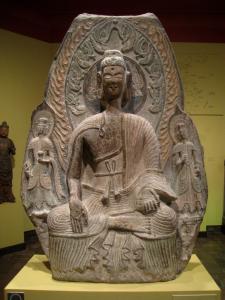
With that being said, Chinese culture also managed to transformed Buddhism. This was no more apparent than on the level of popular apocalyptic thinking. The themes, terms, symbols, and ideas of Buddhism soon found their way into the doctrines of the popular religious sects. As Seiwert notes, “Buddhist practices, as the burning of incense, and probably also certain Buddhist ideas were assimilated by popular sects as early as the late second century. As Buddhism took roots among the lower classes and the peasant population, it became part of the popular religious tradition” (103). In this sense, Buddhist thought quickly diffused throughout China, establishing itself as one of the nation’s main cultural pillars. But these popular sects did not just adopt Buddhism wholesale. They reconfigured it in fundamental ways, making it more amenable to their own pre-existing beliefs and expectations. This is how Buddhism became, for the first time, an apocalyptic faith.
By all accounts, Buddhism in its original context was not apocalyptic, except perhaps in the very loosest of senses. The world in Buddhist thought had existed for countless eons and would exist for countless more. Sudden upheavals and imminent changes to the form or the makeup of the cosmos were not to be expected by the faithful. As with Augustine’s understanding of history, orthodox Buddhist held that the world would just keep going along in its present state until well into the deep future. There would eventually be a moment of destruction at the end of the world-age, or kalpa, but that moment was so astronomically distant in time that it was neither a source of dread nor longing. Besides, annihilation would simply clear the way for a new world that, in all important respects, was just like the old one. As Erik Zürcher says in “‘Prince Moonlight’: Messianism and Eschatology in Early Medieval Chinese Buddhism,” this view of history “can hardly be called eschatological in the proper sense of the word. In the Buddhist complex, the dissolution of the ‘receptacle-world’ is not coupled with a final judgment, nor with a separation of the saved and the damned, and certainly not with the establishment of a New Heaven and a New Earth” (Zürcher 7). In short, the world to come is no future paradise but just more of the same. In this cyclical view of history, the same cycle of rebirth and suffering would play out in the new world just as it had in all the worlds that had existed before our own.
Perhaps it would be going too far to label this conception of historical time as pessimistic, but it was certainly one that offered very little in terms of worldly hope. Escape was only possible on an individual level through attaining enlightenment; in the world at large, the current bad state of things would continue indefinitely. But then Buddhism came to China and its view of history underwent a sea-change. No longer caught in an endless cycle, time started going somewhere. Eschatology became a part of Buddhism. This was down in large part to Buddhism’s failure to eradicate the deeply rooted apocalyptic ideas that already existed in China. It only managed to change their outward forms from Taoist to Buddhist, leaving their inner substance intact. As Zürcher notes, it is in China that
we can observe the formation of a Buddho-Taoist eschatology, in which the main actors—and in any case the person of the superhuman savior himself—are of Buddhist origin, and in which conceptual, stylistic, and terminological elements are largely borrowed from popular Mahāyāna devotionalism. But even if most of the dramatis personae and much of the style and imagery are of Buddhist origin, it is clear that Taoism provided the model for the structure as a whole. (10)
While Buddhism foisted its names and symbols onto the indigenous eschatological tradition, that tradition pushed its main ideas onto Buddhism, at least in its popular varieties. Thus, in popular Chinese Buddhism, the end of the world was not in the distant future, but very near at hand. A new paradise awaited on the other side, and there was a pressing need to earn passage from the present, doomed world into the one that was about to be born. Crucially, this transition was to be shepherded by something previously unknown in Buddhism: a future messiah.
Buddhist messianism arose first in China. That is not to say that the seeds did not come from India. The messianic figures adopted by Chinese end-times believers had already been a part of the faith in its native land. But they were not yet messiahs in India or in any of the lands to which the faith had previously spread. It fell to the Chinese to completely refashion these characters and their roles in the religion. Sometimes, they found warrant for this through unique interpretations of existing Buddhist lore. Other times, they were more inventive, creating a new messiah whole-cloth with little more than a name to go on. This was certainly the case with the intriguing character that Zürcher calls “Prince Moonlight.”
Prince Moonlight (Yueguang tongzi, “moonlight boy,” in Chinese) was originally an obscure bodhisattva mentioned briefly in a few texts of the Mahayana school of Buddhism. Why this otherwise undistinguished figure was selected for special notice by the Chinese will probably never be known but, in a moment lost to history, he ceased to be just another name in a list of Buddhas and became China’s messianic savior. The oldest surviving reference to this belief is found in a fourth-century letter of Xi Zuochi—he who famously championed Shu-Han’s legitimacy before the Jin court—but it seems to have really gotten going two-hundred years later, in the sixth century. At that time, a Chinese translation of Prince Moonlight’s Indian biography would interpolate a prophecy to the effect that, in Zürcher’s words, “when the canonical doctrine is about to disappear, Yueguang tongzi will be reborn in China … as a saintly ruler. He will revive the True Doctrine in all the Western Regions and among the surrounding barbarians. They will be converted in great numbers, and all who listen to the words of this scripture will be saved from sin” (24). At this moment in time, Prince Moonlight is clearly established not only as a Buddhist savior, but as a Chinese one. He will be born in China to undertake his messianic role and it is in China that he will work to restore Buddhism and set the world right. His national identity and his salvific role have become complete intertwined at a time when Buddhism itself was taking on the characteristics of a national faith.
From here, Prince Moonlight’s development proceeded along two different but interconnected routes. In one, he would function as something like the Last World Emperor in early medieval Christian apocalypticism; he is a heroic political ruler who will reestablish the true faith throughout the world but, in a relatively short time, this achievement comes undone and the world plunges into complete darkness. This is the narrative featured in the Fa miejin jing (Sutra on the Extinction of the Dharma). There, Prince Moonlight restores the world and reinvigorates the faith following an apocalyptic catastrophe. But, as Seiwert caustically remarks, “This restoration will, however, last only for a short period of fifty-two years” (Seiwert 115). According to Zürcher, “after that last splendor … the process of decay continues; one after another, the sacred scriptures vanish from this world, and mankind is steeped in spiritual darkness” (Zürcher 28). In this narrative, then, Prince Moonlight offers hope but only on a limited scale. For fifty-two years, the world will be a utopia and Buddhism will flourish. But in the end, all this will come to an end and the course of history will continue as Buddhist orthodoxy says it must, with things getting worse and even Buddhism itself disappearing. Just as the Last Emperor could not stop the coming of the Antichrist, the Moonlight messiah cannot prevent the world’s slide into ignorance and further degradation.
Still, despite the limited nature of the salvation he offered, this version of Prince Moonlight soon became a popular and potent political figure, much as the Last Emperor did in the west. Even the first emperor of the Sui Dynasty claimed to be Prince Moonlight come to save the world. Like the succeeding Tang Dynasty with its cooption of the Li Hong narrative, Emperor Wen saw an obvious advantage in presenting himself as a long-awaited messianic figure. Given that his dynasty lasted four decades and the Tang lasted nearly three centuries, Sui Wendi’s messianic claim does not seem to have gained quite the same traction as theirs did. But that did not extinguish the interest Chinese monarchs had in this character. China’s only official female monarch, Wu Zetian, in her bid to replace the Tang Dynasty, would also claim to be Prince Moonlight. She tweaked the prophecy so that Moonlight was destined to be born in a female body—thereby creating the idea of a genderbending savior. As interesting as that innovation may have been, her efforts to identify herself with this particular messiah met with about as much success as the first Sui Emperor’s had a century before.
Associating with Prince Moonlight does not seem to have done much for dynastic longevity. Perhaps this was the first indication of how little staying power he actually had, for his time as a popular messiah was comparatively short-lived. Regardless, it is clear that the portrayal of Moonlight as a great final ruler appealed quite heavily to China’s actual rulers. But there was another way of viewing him, one that met with far less official favor. In popular thought, the Moonlight child became not just a future king but a true messiah who will play a pivotal role in the events of the end-times. In a text called the Shouluo jing (Book of Shouluo), Prince Moonlight is called the “King of Light.” He teaches the faithful how to escape the coming destruction of the world and, after an apocalyptic final battle, “he will be king in the territory of Han” (qtd. in Zürcher 39). The mention of the “territory of Han” might suggest a connection to the old prophecy of a messianic future Han Emperor—references to the Han seem to crop up quite a lot in Buddhist millennialist texts around this time and in contemporary rebellions such as Faqing’s. But the important thing is that, in this text, Prince Moonlight steps into his own as a transformative, salvific figure. He will appear at the end of the world, save the faithful, and rule over a new paradise that comes into being after the cosmos’s annihilation. He even gets a Last Emperor figure of his own, for Daniel Overmyer notes in Precious Volumes that “an unnamed king and his officials are expected to aid the messiah by exhorting all to be good Buddhists” (Overmyer 21). It is not a brief period of respite that he ushers in but instead the “New Heaven and New Earth” that Zürcher insists was previously absent from Buddhist thought.
This more clearly messianic form of Prince Moonlight proved as popular as the less radical version discussed above. But his influence would be felt outside the halls of power, inspiring rebellions and seditious movements, most notably in 516 or 517 when a seven or eight-year-old boy Liu Jinghui was proclaimed to be the long-awaited messiah. Perhaps the fact that the boy’s surname was Liu—the same as that of the Han Dynasty emperors—furthered suggests a connection between the Prince Moonlight and Han restoration prophecies. But if there was some political agenda there, it never amounted to anything. This particular sect was soon broken up by the authorities and little came of it. A more significant manifestation of Prince Moonlight belief may have occurred during the first Buddhist rebellion in China, that of Hou Ziguang in 337. Seiwert believes that Jin officials taking note Hou being “an attractive boyish young man” (Seiwert 107) might indicate that Hou saw himself as the Moonlight messiah. If nothing else, it is a reminder that the characteristics embodied by the Moonlight boy had acquired a subversive connotation in early medieval China.
However, Prince Moonlight’s tenure as popular national savior would soon come to an end. He was soon to be upstaged by another Buddhist messiah, one who came with an orthodox pedigree that far outshone that of the Moonlight boy. This Buddhist messiah, who would become the Buddhist messiah as far as the eastern Asian cultural milieu was concerned, was Maitreya. Unlike Prince Moonlight, Maitreya had been a central figure in Buddhism long before it ever arrived in China and, also unlike Prince Moonlight, he had always been associated with a glorious future age. In this sense, he could already be considered a kind of messiah. Yet it is a type far different from what most uses of that term would indicate.
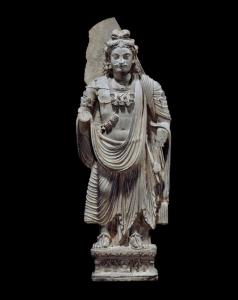
In Buddhism as it is conventionally understood, the founder of the faith and the figure generally known simply as the Buddha is Siddhartha Gautama, also called Sakyamuni. He is the Buddha responsible for the current and ongoing promulgation of the faith’s teachings. But he is not the first Buddha. Many Buddhas came before him, restoring the tenets of Buddhism to the world for a time before those doctrines were lost again. Nor is he the last Buddha, for his teachings shall someday also be lost and will need to be restored by future Buddhas. The first restorer will be Maitreya. He is the next Buddha to come after Siddhartha Gautama. It will fall to him to revive Buddhism and restore its teachings to the world after the long period of dormancy that shall result from the extinction of Gautama’s memory.
In this sense, at least, Maitreya can be called a figure of future hope, insomuch as he represents the survival and reinvigoration of Buddhism in the time to come. What is more, the world of Maitreya’s era will look very much like the paradises that anchor so many millennialist dreams. In what is another intriguing parallel to the Last World Emperor—religious eschatology just cannot seem to avoid making political figures into adjunct-saviors—the future era will see the rise of a chakravartin (a “wheel-turning king”; the term indicates a universal ruler) who would unify the whole world. His reign is to be a time of unequaled peace and prosperity, when people will live for eighty-thousand years and know nothing of pain or disease. Seiwert recounts, “At this time, when the surface of the earth will be even and without obstacles, the harvests are plentiful and eighty thousand great cities provide a life free of sorrow and full of bliss, a new buddha will appear. His name is Maitreya tathagatha” (124). This new Buddha will complete the remarkable transformation begun by the chakravartin by adding the missing spiritual element to it, beginning a glorious new epoch for the faith. His success at converting the masses to Buddhism will far outshine Gautama’s, crowning this near-perfect time with an unprecedented flowering of the Buddhist religion.
This seems, in many respects, to accord with the millenarian expectations of the world’s other faiths. We see many of the same key ingredients; a world-uniting savior-king, the triumph of the true faith, and even such recurring motifs as the earth’s future fertility and the flatness of the terrain. Admittedly, the roles of religious and physical salvation are separated here, requiring two saviors in Maitreya and the Chakravartin. But that is not an uncommon occurrence. We saw the same thing in the Dead Sea Scrolls and in the Last World Emperor myth. It also occurs in China, as the Liu-and-Li and Prince Moonlight prophecies show. Everything seems to be within the usual remit of religious eschatology. Indeed, at first glance, Maitreya in his original form already looks much like a true Buddhist messiah.
But scholars caution against making too much of Maitreya’s apparently messianic role in early forms of Buddhism. Zürcher remarks that “in the orthodox tradition, Maitreya is, basically, a teacher and a revealer of the Doctrine. He will reach Buddhahood in the distant future, in a situation of peace and universal well-being—he is certainly not a messiah who saves his chosen people from disasters and establishes an ideal state” (Zürcher 10). Zürcher’s remark goes a little too far in denying the original Maitreya a messianic role because he is primarily a religious teacher—we have already seen how a religious-political messiah pair is not uncommon in world religions—but his comment about Maitreya’s appearing in the “distant future” is far more pertinent. Seiwert elaborates on this point further, stating,
in this tradition [Hinayana, the oldest branch of Buddhism] Maitreya has nothing to do with any messianic or otherwise eschatological expectations. His appearance is prophesized for a time after millions of years, which could hardly inspire the hope for an imminent advent of this golden age … the wish to live in this world localized in the distant future of millions of years could only be realized in one of the future rebirths.” (Seiwert 125-26)
For all of its glories, the age of Maitreya was not something that could be eagerly awaited or hopefully anticipated. It was not to come in a few years, or even a few hundred or thousand years. It would be many millions of years before the world would reach this paradisal state and the new Buddha would come.
In a sense, this is not so different from the trick St. Augustine pulled, pushing the advent of the New Jerusalem so far into the future that it lost any real relation to the present world and thus any true significance for the average believer. The number of years that will pass until Maitreya’s coming is so large that it is impossible for an ordinary mind to fathom. Despite all that it has in common with the millennial eras and new earths of other faiths, the original form of the Maitreya narrative does not function as a source of apocalyptic hope. Maitreya can be appealed to for aid by individual devotees while he dwells in the Tuṣita heaven and waits to be reborn—after all, with his advent being so far away, he has plenty of time on his hands—but he makes no promises of general salvation or global transformation for Buddhists living in the present. What is more, his era, as glorious as it may be, is destined to degrade into a world much like our own and then into a worse one. The traditional Buddhist scheme allows no age to be permanent and thus even the future paradise must eventually cease to be. Maitreya’s own teachings will be forgotten and, eventually, another Buddha will come along to reestablish the faith once more.
We can see that while Maitreya already possessed many of the features of a messiah, these were effectively neutered by Buddhism’s fascination with long timescales and the emphasis it placed on inevitable decline. It could perhaps be said that Maitreya at this stage had messianic potential but that is was locked behind the strictures of orthodox Buddhist doctrine. “The tradition of Maitreya as the future Buddha,” Seiwert notes, “became a central feature of Buddhist eschatology only in China” (124). It was in China that that potential was unlocked for the first time, with Maitreya becoming a savior whose advent was expected on a more reasonable timescale and a source of eschatological hope.
When Maitreya entered China, he was still viewed in a largely non-messianic way. Indeed, his worship among orthodox Buddhists was meant to secure rebirth in his Tuṣita heaven after death and had no real relation to a hopeful future for this world. But by the sixth century, Amitabha, who offered believers rebirth in his own Pure Land, muscled Maitreya out of this role and has kept a tight grip on it ever since. Stripped of his important orthodox function, Maitreya had only those suppressed messianic attributes to fall back on. And when they came into contact with China’s already well-developed apocalyptic tradition, those attributes activated. Soon, as far as popular religion was concerned, Maitreya’s advent was no longer set for fathomless eons in the future. He was coming soon and everyone needed to get ready. With this new urgency and new hope behind him, Maitreya did some muscling in of his own. He entered into the Chinese apocalyptic scheme with aplomb, shoving all other looked-for saviors to the sidelines as he took center stage in the nation’s end-times drama.
Maitreya’s ascent to undisputed savior was not immediate. He coexisted with the messiahs already established in the Chinese scene, sometimes quite literally. The Taishing Lingbao Laozi huahu miaojing (Wondrous Scripture of the Most Exalted Lingbao Teachings Concerning Laozi Converting Foreigners) has Maitreya working with the “True Lord of Great Peace”—a title belonging to the old Taoist savior, Li Hong—while the Zhengming jing (Testimonial Scripture) announces that “Heaven will produce a King of Light and Earth will produce a Sage Lord” (qtd. in Overmyer 18). This suggests some kind of team-up between Maitreya and either Prince Moonlight or Li Hong, who was also known as “Sage Lord” or “Holy Ruler.” The latter text also makes clear that, as Overmyer puts it, Maitreya can only appear “following thirty years of rule by a ‘king of the Dharma’” (Overmyer 17). This righteous ruler probably is Moonlight once again takes on a kind of Last Emperor role by preparing the way for the true savior’s coming, thereby refashioning Maitreya’s relationship with the chakravartin in a more apocalyptic mode. For a time, Chinese eschatology seemed content to adopt a two-messiah model. But this hamonious symbiosis did not last. Maitreya quickly displaced both Li Hong and the Moonlight boy, fully absorbing their roles and becoming the only messiah in the mainline of Chinese apocalyptic thought. He would prove to have the staying power and longevity that they never enjoyed, remaining the major messiah in Chinese eschatology and the focal point of hope for the nation’s many millenarian sects for well over a thousand years, right through the end of the imperial era. It was only with Christianity’s greater penetration into China in the twentieth century that another messiah, Christ himself, would shake Maitreya’s monopolistic grip on Chinese end-times speculation.
Still, for a vast swath of time, Maitreya’s hold on the Chinese millennialist imagination was unchallenged. For all the attention given to Taoists like the Yellow Turbans and the Five Pecks of Rice at the end of the Han or the eccentric Christianity of the Taiping rebellion at the end of the Qing—its name, if nothing else, a reminder of how old millennialist ideas die hard in China—most of the millennialist movements and religious rebellions in Chinese history were centered upon the coming of the future Buddha. As Seiwert bluntly observes, “The figure of Maitreya as the herald of a new era had been absorbed by the popular religious culture” (Seiwert 120); his book chronicles the many militant movements and rebellions, from the Dacheng revolt led by Faqing in the sixth century to the Bagua rising in the nineteenth, that were launched in Maitreya’s name. Several prophecies referred to Maitreya’s white clothes and banner, causing his devotees to themselves utilize white clothes, banners, and—in one 618 incident that might suggest a link to the Hindu messiah Kalki—a white horse. This became enough of a fashion trend that the Sui emperors, still eager to associate themselves with messianic prophecy, took part. While this fact may suffice to show how long a shadow Maitreya cast over even the upper echelons of Chinese society, it was a dynasty much later than the Sui that bore the full brunt of his popularity. For the high point of Maitreyan influence on Chinese politics and culture came at the end of the Yuan Dynasty.
At that time, a man named Han Shantong announced that “the empire will be in great disorder and Maitreya will be born” (qtd. in Seiwert 201). This began a rebellion centered upon the idea of replacing then-ruling dynasty of the Mongols with Han—who was claimed to be a descendant of Emperor Huizong of the Song Dynasty—all in preparation for Maitreya’s advent and the world’s transformation. After Han’s death, his son was proclaimed the “Lesser King of Light” (Xiao Mingwang)—a title belonging to Prince Moonlight in the Shouluo jing and to Maitreya himself in the Zhengming jing. Perhaps the designation of “lesser,” “little,” or subordinate king was meant to suggest the mythical monarch who aids Maitreya in the latter text. As it played out historically, Maitreya never arrived. Leadership of the rebellion instead devolved to a man by the name of Zhu Yuanzhang. He and his rebel forces would actually succeed in driving the Yuan Dynasty from China and creating a new political order in their place. Zhu Yuanzhang became the first Emperor of the Ming Dynasty. The dynasty’s name itself came from the same word for “bright” or “light”—明 ming—that was found in the messianic “King of Light” title and which had long been used in apocalyptic texts to speak of coming saviors such as Maitreya and Prince Moonlight.
The rebellion that established the Ming Dynasty was thus the most successful messianic movement in Chinese history. Earlier messianic rebellions, such as that of the Yellow Turbans, had certainly rearranged the political landscape. And earlier dynasties, such as the Tang, had utilized messianic prophecies to fuel their rise to power. But never had these two trends melded together so fully and so successfully as they had at the birth of the Ming. For the first time in history, an uprising that had begun on explicitly apocalyptic and millennialist terms had managed to impose its own political order and vision for society upon the whole of China. It is true that, pretty much as soon as it came to power, the Ming ditched most of those apocalyptic trappings and ruled as a fairly standard imperial dynasty. The red color under which the rebels marched may have had an eschatological meaning for them, but for the Ming as a ruling institution, it instead suggested a link to the ancient Han Dynasty and encouraged a very different model for ruling the new China that they had created. That model emphasized continuity and the established ways of doing things, dissipating any of the radical potential that had originally existed in Han Shantong’s Maitreyan rebellion.
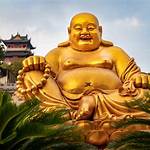
Still, that the Ming Dynasty came into being at all is a testament to the extensive sway Maitreya had over the Chinese popular imagination. This was so great that neither the Ming’s apparent fulfillment of Maitreyan prophecy nor the disappointment wrought by its subsequent bureaucratic turn could do much to dampen popular belief; the Buddha-to-be’s influence had sunken too deep into the culture at large. Even today, that influence can still be detected in the most seemingly innocuous of places. The ubiquitous figure of “laughing Buddha,” is not in fact a representation of Siddhartha Gautama but an incarnation of Maitreya, demonstrating that the future savior is still tightly interwoven into China’s cultural fabric to this day. The Ming themselves would soon discover how hard it was to cool the fires of Maitreyan expectation. If anything, their use of the prophetic narrative had only fanned those flame, as the Ming period would see one of Chinese history’s most extensive flowerings of apocalyptic thought. Indeed, it is during the era of Ming rule that we find the first traces of the distinctive Three Ages doctrine that would come to define Chinese eschatology ever afterward.
Works Cited
Overmyer, Daniel L. Precious Volumes: An Introduction to Chinese Sectarian Scriptures from the Sixteenth and Seventeenth Centuries. Cambridge: Harvard University Press, 1999.
Seiwert, Hubert. Popular Religious Movements and Heterodox Sects in Chinese History. Leiden: Brill, 2003.
Zürcher, Erik. “‘Prince Moonlight’: Messianism and Eschatology in Early Medieval Chinese Buddhism.” T’oung Pao, vol. 68, no. 1-3 (1982): 1-75.


